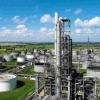|
|

Heat Exchanger Design
#1

Posted 14 September 2007 - 12:19 PM
Now cooling water is used in Cooler. In cooler part of water is being condensed which is being removed afterwards using knock out drum.
Now I have given a task to convert this water cooled Exchanger to process cooled Ex. So I want to know from I'll get the calculation formulas for such design.
Rocky
#2

Posted 14 September 2007 - 01:56 PM
Rocko:
I wish engineers who contribute a query would be 100% candid and give us all the possible basic data that they have or know about. Why do they behave like “secret squirrels” and keep the necessary basic data that is needed to respond to themselves?
Anyway, what you describe is just too mixed up and written so badly that it is hard to understand what you basically have and what you are asking. Therefore I had to do some brief research and find that you are trying to describe the Sohio Process for direct oxidation and Nitration of Propylene in a fixed bed reactor. This is all detailed and explained clearly at:
http://www.che.lsu.e...iller/paper.htm
If you had given us this type of information, it would be much easier to understand what you mean and what you are trying to do. You obviously have this information, so why don’t you share it with those that you are asking a favor from?
Anyway, I “think” you have a process shell & tube cooler directly after the Water Absorption Column and you have been assigned to replace the cooling water in the process cooler with another process stream and you are asking for a “secret formula” to calculate the correct heat exchanger (hopefully with only one unknown and a constant). Let me spare you a lot of grief, lost time, and effort: There is no such formula. There never has been, and never will be. Sorry.
I recommend you read, study, and absorb all the related information to be found in Donald Kern’s famous Opus, “Process Heat Transfer” in order to rate the existing exchanger and come up with the correct answer. You will even find worked examples in Don’s book. When you go through this process, you will appreciate the fact that the only sole formula that exists for such an application is a general one used by all engineers: hard work and ingenuity.
Good luck on your project.
#4

Posted 17 September 2007 - 08:10 AM
Call me Mr. Cynical but I reckon this is a student design project and they could be looking for free answers.
And we know from previous posts your not too fond of that
(Rocky - my apologies if i'm totally wrong here)
#5

Posted 23 September 2007 - 07:28 AM
Replies are very helpful in all manners.
As Art Montemayor has said that "Why do they behave like “secret squirrels” and keep the necessary basic data that is needed to respond to themselves?"
I want to clarify that this was my first design query. Thats why, may be, my questioned sounds "too mixed up". I was just asking whether anybody can help me on this topic. I have not posted each n every detail as I thought it may be too confusing! If some body would have asked any clarification I would have given.
[Just for knowledge] The link which you have attached perfectly describe the process but you may have noticed that figure does not have that exchanger about which I am talking, which lies between Reactor and Absorber Column!!
I know basic calculation for heat exchanger design and have not asked about any "secret formula"!! The only thing I was asking was how should I calculate the Reynold's No calculation, heat transfer coefficient in case of Partial Condensation where more than one component are present. As you have suggested to refer D.Q. Kern, I'll get from my company's library n surely go through it. Thanks for your valuable suggestion!! Just one more help. Give me some detail about Don's book like its name.
I may sound a bit harsh in answering to your reply [if so I m sorry.] but please my intention is to explain my point. I do not know whether I can share some of my operational data with everybody on the web or not thats, I feel, my might be little confusing. Sorry for that!
Thank you, JoeWong!! I have gone through those contents found helpful. Thanks once again!!
Answer of JEBradley's opinion is "NO". I am working in a company. You are excused for that
#6

Posted 24 September 2007 - 03:17 AM
Kern's book is simply called 'Process Heat Transfer'. There are, of course, other references - Coulson & Richardson Vol 6 p659 for example. I find Kern's book unreadable, don't know why.
#7

Posted 03 June 2011 - 03:47 AM
Rocko,
Please ,just apply your mind to the Basic heat transfer formulae.
Nusselt no;Prandtl no and Reynolds no.All tht you need to do is to input properties values correctly to the appropriate fluids. at the Design /operating conditions. Refer Don and Ludwig
Do you agree?
Best wishes,
T.S.Murali
Rocko:
I wish engineers who contribute a query would be 100% candid and give us all the possible basic data that they have or know about. Why do they behave like "secret squirrels" and keep the necessary basic data that is needed to respond to themselves?
Anyway, what you describe is just too mixed up and written so badly that it is hard to understand what you basically have and what you are asking. Therefore I had to do some brief research and find that you are trying to describe the Sohio Process for direct oxidation and Nitration of Propylene in a fixed bed reactor. This is all detailed and explained clearly at:
http://www.che.lsu.e...iller/paper.htm
If you had given us this type of information, it would be much easier to understand what you mean and what you are trying to do. You obviously have this information, so why don't you share it with those that you are asking a favor from?
Anyway, I "think" you have a process shell & tube cooler directly after the Water Absorption Column and you have been assigned to replace the cooling water in the process cooler with another process stream and you are asking for a "secret formula" to calculate the correct heat exchanger (hopefully with only one unknown and a constant). Let me spare you a lot of grief, lost time, and effort: There is no such formula. There never has been, and never will be. Sorry.
I recommend you read, study, and absorb all the related information to be found in Donald Kern's famous Opus, "Process Heat Transfer" in order to rate the existing exchanger and come up with the correct answer. You will even find worked examples in Don's book. When you go through this process, you will appreciate the fact that the only sole formula that exists for such an application is a general one used by all engineers: hard work and ingenuity.
Good luck on your project.
Similar Topics
Steam Pressure In Heat ExchangerStarted by Guest_mvanrijnbach_* , 15 Apr 2025 |
|

|
||
Scrubber DesignStarted by Guest_nasss_* , 07 Aug 2024 |
|

|
||
Refinery Lpg Deethanizer Column DesignStarted by Guest_Ilyes_* , 15 Feb 2025 |
|

|
||
Heat Exchanger Steam FlowStarted by Guest_aliebrahem17_* , 25 Nov 2024 |
|

|
||
Discussion - Predict Storage Tank Heat Transfer Precisely By Jimmy D KStarted by Guest_raj shekhar_* , 25 Mar 2025 |
|

|

 FB
FB








